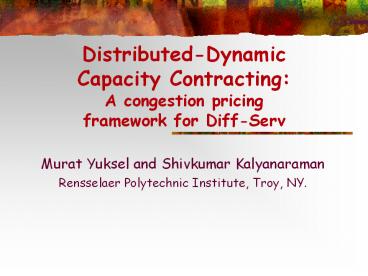Distributed-Dynamic Capacity Contracting: A congestion pricing framework for Diff-Serv - PowerPoint PPT Presentation
Title:
Distributed-Dynamic Capacity Contracting: A congestion pricing framework for Diff-Serv
Description:
Distributed-Dynamic Capacity Contracting: A congestion pricing framework for Diff-Serv Murat Yuksel and Shivkumar Kalyanaraman Rensselaer Polytechnic Institute, Troy, NY. – PowerPoint PPT presentation
Number of Views:77
Avg rating:3.0/5.0
Title: Distributed-Dynamic Capacity Contracting: A congestion pricing framework for Diff-Serv
1
Distributed-Dynamic Capacity Contracting A
congestion pricing framework for Diff-Serv
- Murat Yuksel and Shivkumar Kalyanaraman
- Rensselaer Polytechnic Institute, Troy, NY.
2
Overview
- Motivation/Context
- Framework Dynamic Capacity Contracting (DCC)
- Scheme Edge-to-Edge Pricing (EEP)
- Distributed-DCC
- Simulation Experiments
- Summary
3
Motivation/Context
- Multimedia (MM) applications introduce extensive
traffic loads. - Hence, better ways of managing network resources
are needed for provision of sufficient QoS for MM
applications. - For this purpose, congestion pricing is one of
the methods among many others. - Two major implemetation problems
- Timely feedback about price
- Congestion information about the network
4
DCC Framework
5
DCC Framework (contd)
- Solves implementation issues by
- Short-term contracts, i.e. middle-ground between
Smart Market and Expected Capacity - Edge-to-edge coordination for price calculation
- Users negotiate with the provider at ingress
points - The provider estimates users incentives by
observing users traffic at different prices - A simple way of representing users incentive is
his/her budget - Budget estimation
6
DCC Framework (contd)
- The provider offers short-term contracts
- is price per unit volume
- Vmax is maximum volume user can contract for
- T is contract length
- Pv is formulated by pricing scheme at the
ingress, e.g. EEP, Price Discovery - Vmax is a parameter to be set by soft admission
control
7
DCC Framework (contd)
8
DCC Framework (contd)
- Key benefits
- Does not require per-packet accounting
- Requires updates to edges only
- enables congestion pricing by edge-to-edge
congestion detection techniques - deployable on diff-serv architecture of the
Internet
9
Edge-to-Edge Pricing (EEP)
- At Ingress i, given and
- Balancing supply (edge-to-edge capacity) and
demand (budget for route ij) - If is congestion-based (i.e. decreases when
congestion, increases when no congestion), then
becomes a congestion-sensitive price. - formulation above is optimal for maximization
of total user utility.
10
Distributed-DCC
- DCC distributed contracting, i.e. flexibility
of advertising local prices - Defines ways of maintaining stability and
fairness of the overall system - Operates on a per-edge-to-edge flow basis
- Major components
- Ingresses
- Egresses
- Logical Pricing Server (LPS)
11
Distributed-DCC (contd)
12
Distributed-DCC (contd)
13
Distributed-DCC (contd)
14
Distributed-DCC (contd)
- Congestion-Based Capacity Estimator
- Estimates available capacity for each flow
fij exiting at Egress j - To calculate it uses
- Congestion indications from Congestion Detector
- Actual output rates of flows
- Increase when fij generates congestion
indications, decrease when it does not, e.g.
15
Distributed-DCC (contd)
- Fairness Tuner
- Punish the flows causing more cost!
- Punishment function
- A particular version by using from Flow Cost
Analyzer - Max-min fairness, when
- Proportional fairness, when
16
Distributed-DCC (contd)
17
Distributed-DCC (contd)
- Capacity Allocator
- Receives congestion indications, and
- Calculates allowed capacities for each flow
- Hard to do w/o knowledge of interior topology
- In general,
- Flows should share capacity of the same
bottleneck in proportion to their budgets - Flows traversing multiple bottlenecks should be
punished accordingly
18
Distributed-DCC (contd)
- An example Capacity Allocator
- Edge-to-edge Topology-Independent Capacity
Allocation (ETICA). - Define for flow
- Define as congested, if .
19
Distributed-DCC (contd)
- An example Capacity Allocator (contd)
- Allowed capacity for flow
- Intuition If a group of flows are congested,
then it is more probable that they are traversing
the same bottleneck. - Assumes no knowledge about interior topology.
20
Simulation Experiments
- We want to illustrate
- Steady-state properties of Distributed-DCC
queues, rate allocation - Distributed-DCCs fairness properties
- Performance of the capacity allocation in terms
of adaptiveness.
21
Simulation Experiments (contd)
22
Simulation Experiments (contd)
- Propagation delay is 5ms on each link
- Packet size 1000B
- Users generate UDP traffic
- Interior nodes mark when their local queue
exceeds 30 packets. - User with a budget b maximizes its surplus by
sending at a rate b/p. - For each contracting period, users budgets are
randomized with truncated-Normal. - Contracting 4s, observation 0.8s, LPS 0.16s.
- k is 25, i.e. a flow stays in congested states
for 25 LPS intervals, or one contract period.
23
Simulation Experiments (contd)
- Single-bottleneck experiment
- 3 user flows
- Flow budgets 30, 20, 10 respectively for flows 0,
1, 2. - Simulation time 15,000s.
- Flows get active at every 5,000s.
24
Simulation Experiments (contd)
25
Simulation Experiments (contd)
26
Simulation Experiments (contd)
27
Simulation Experiments (contd)
- Multi-bottleneck experiment 1
- 10 user flows with equal budgets of 10 units.
- Simulation time 10,000s.
- Flows get active at every 1,000s.
- All the other parameters are the same as in the
PFCC experiment on single-bottleneck topology. - ? is varied between 0 and 2.5.
28
Simulation Experiments (contd)
29
Simulation Experiments (contd)
30
Simulation Experiments (contd)
- Multi-bottleneck experiment 2
- 4 user flows
- Simulation time 30,000s.
- Increase capacity of node D from 10Mb/s to
15Mb/s. - All flows get active at the starts of simulation.
- Initially all flows have equal budget of 10
units. Flow 1 temporarily increases its to 20
units between times 10,000 and 20,000. - ? is 0.
31
Simulation Experiments (contd)
32
Simulation Experiments (contd)
33
Summary
- Deployability of congestion pricing is a problem.
- A new congestion pricing framework,
Distributed-DCC - Middle-ground between Smart Market and Expected
Capacity. - Deployable on a diff-serv domain.
- A range of fairness capabilities.































